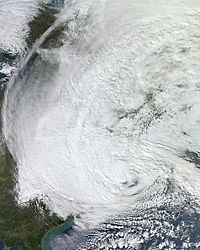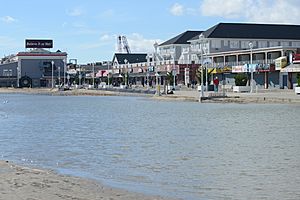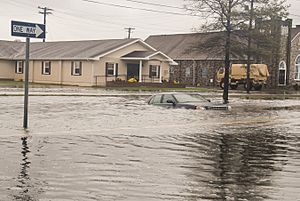Effects of Hurricane Sandy in Maryland and Washington, D.C facts for kids
| Post-tropical cyclone (SSHWS/NWS) | |

Satellite image of Sandy near landfall
|
|
| Winds | 1-minute sustained: 60 mph (95 km/h) Gusts: 80 mph (130 km/h) |
|---|---|
| Fatalities | At least 11 total |
| Damage | $13.55 million (2012 USD) |
| Areas affected | Maryland, Washington, D.C. |
| Part of the 2012 Atlantic hurricane season | |
Hurricane Sandy was a very powerful storm that hit the East Coast of the United States in October 2012. In Maryland and Washington, D.C., the storm brought strong winds, heavy snow in some areas, and lots of flooding along the coast. People had to get ready for the storm, and it caused many changes to daily life.
Contents
Getting Ready for Sandy
Washington, D.C. Prepares
On October 26, 2012, the mayor of Washington, D.C., Vincent Gray, announced a state of emergency. This meant the city could quickly get help and resources ready for the storm. The governors of nearby states like Pennsylvania, Maryland, and Virginia also declared emergencies.
Many federal government offices in Washington, D.C., were closed on October 29 and 30. The city's public transportation, called Metro, stopped all train and bus service on October 29. This was because of the expected strong winds and possible power outages. Even the famous Smithsonian Institution museums closed for the day.
Maryland Gets Ready

In Maryland, people on Smith Island had to leave their homes with help from the police. Shelters were opened in Dorchester County for people living in areas that might flood. Ocean City started its emergency plan to prepare for the storm.
Power companies like Baltimore Gas and Electric Co. got their workers ready and even planned to bring in crews from other states to help. On October 28, President Obama declared an emergency for Maryland. This allowed the Federal Emergency Management Agency (FEMA) to help with disaster relief. Many areas, including parts of Ocean City, Worcester County, Wicomico County, and Somerset County, were told to evacuate.
The Maryland Transit Administration canceled all bus, light rail, and train services for October 29 and 30. Six shelters opened in Baltimore, and early voting for elections was canceled for one day. Maryland's Insurance Commissioner made a rule that pharmacies had to refill prescriptions, even if it was too soon for a normal refill. On October 29, major bridges like the Chesapeake Bay Bridge and bridges over the Susquehanna River were closed because of the strong winds.
Sandy's Impact
How Washington, D.C. Was Affected
The Supreme Court did not meet on Tuesday, October 30. Federal offices in Washington, D.C., stayed closed on October 29 and 30 but reopened on October 31. Schools were also closed for a second day. While some trains and buses were still not running on October 30, the Metro system started running again in the afternoon on a Sunday schedule.
How Maryland Was Affected

Hurricane Sandy caused a lot of damage in Maryland. In Ocean City, about 100 feet of a fishing pier was destroyed. Governor Martin O'Malley said the pier was "half-gone." The Chesapeake Bay Bridge had to close due to high winds but later reopened. Another bridge, the Millard E. Tydings Memorial Bridge on I-95, also closed.
Due to heavy flooding, the mayor of Salisbury announced a curfew from 7 p.m. on October 29 to 10 a.m. on October 30. In western Maryland, I-68 closed because of very heavy snow, leaving many cars stuck. The National Guard was called in to help. In Howard County, Maryland, workers tried to stop a sewage overflow caused by a power outage.
By November 2, most power had been restored. About 28,600 homes were still without power, down from 365,700 right after the storm. Sadly, Hurricane Sandy caused 11 deaths in Maryland. By November 3, Somerset County estimated its damages were around $40 million.
Images for kids


